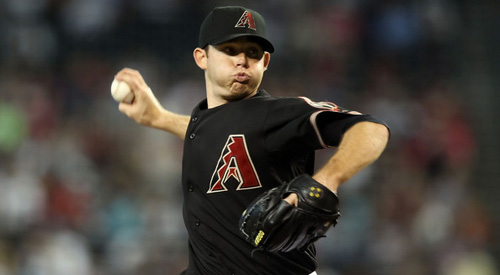
The subtle return of the Arizona Diamondbacks
It’s hard to focus on a team coming off their worst season in team history, but the 2011 Arizona Diamondbacks have already shocked the baseball world by posting a 41-34 record so far. The easily forgotten franchise is tied with the defending World Series Champion San Francisco Giants for first place in the NL West.
How they’ve gotten here since last season is as windy a road as snake slithering through the grass.
Although the team had failed in almost every way in 2009, there were some signs of hope in the desert during the 2010 season. In the offseason, the team landed Ian Kennedy from the New York Yankees via a three-way trade that cost them promising young starter Max Scherzer. Kennedy went on to lead the team with nine wins and 168 strikeouts in 2010.
By the end of last June, however, any shred of optimism for the 2010 season had vanished, the franchise limping to a 31-48 record at the time. Shortly thereafter it was evident the club was going to be a seller at the deadline.
It was at the end of July when the Diamondbacks shook up their roster with a pair of trades, acquiring 23-year-old Daniel Hudson from the White Sox, and shipping their ace, Dan Haren, to the Los Angeles Angels for a package of four players headed by southpaw Joe Saunders. Hudson went 1-1 with a 6.32 ERA after three games for the White Sox in 2010 but finished the year going 7-1 in 11 starts with a 1.69 ERA with the Diamondbacks and Saunders went 3-7 with a 4.25 ERA in 13 starts to close out the year.
To Jim McLennan, lead writer of SBNation‘s Diamondbacks blog AZ Snake Pit, 2010 was indeed a low point for the franchise in recent memory, pointing specifically to the bullpen as a weak link.
[php snippet=1]
“They simply bled runs late on: the Diamondbacks’ record was 6-18 in games tied after seven innings, and 2-14 in games tied after eight. [They] were outscored by a total of 110 runs in the seventh to ninth innings,” said McLennan. “Any way you cut it, the bullpen sucked.”
From Chad Qualls to Aaron Heilman, the club had few late relievers on whom they could rely.
“I think there is an undeniable domino effect: when a team can’t trust the ninth-inning guy, that ripples back to the eighth-inning guy, then the seventh.”
After their midseason trades, the Diamondbacks quickly changed their identity and appeared as a team on the verge of recovery. One of the biggest contributors to the installment of hope was the decision to hire manager Kirk Gibson. The new sense of optimism in the clubhouse carried over to Spring Training in 2011.
General manager Kevin Towers looked to improve the team’s weakest areas over the offseason – strikeouts at the plate and the ineffective bullpen – and made waves over the offseason by trading away Mark Reynolds to Baltimore for relievers David Hernandez and Kameron Mickolio.
Fan reaction was mixed after the trade with many questioning the move.
“For us to take the leaps forward that we think we need to do, we needed to strengthen the pen and we felt that this was a tremendous start” Towers said at the time.
He also signed veteran closer J.J. Putz via free agency, which gave the team its first established closer since the Jose Valverde era.
It’s safe to say that the 2011 campaign has been an overwhelming success for the team so far, the D-backs are currently on pace for 87 wins and have a definite chance at a division crown and a playoff appearance.
“Most expectations for a win total this year were around the mid-70s, with optimistic assumptions that we might get close to .500. So far, obviously, we are well in excess of that. [Towers] had a reputation as a GM who could build a better bullpen, but there were still some eyebrows when he traded Mark Reynolds for a pair of relief arms,” said McLennan.
Scott Allen, lead writer of FanSided‘s Venom Strikes, agrees with McLennan both in that Reynolds deal has paid off and the pitching staff improved.
“The batters have much better approaches at the plate,” said Allen. “They got rid of their high strikeout guys in Mark Reynolds and Adam Laroche. Ian Kennedy and Daniel Hudson have provided an excellent 1-2 punch. Joe Saunders has been serviceable and the D-backs may have found a gem in Josh Collmenter.”
Today Chris Young stands alone as the only D-backs starter who had a place on the team during Opening Day of 2007 (although Micah Owings was there, left, and came back), a testament to the fact that the franchise has become the poster child of a team in rebuild.
Although they may not be home free just yet (they’re still the second worst strikeout team in the NL) they sure have come a long way over the last three years.
Allen also believes that the future of the team is very encouraging, especially with stud batters Paul Goldschmidt and Trevor Bauer, who D-backs fans hope will factor into the ultimate product on the field.
Though there are no guarantees in baseball, the Arizona faithful who’ve spent the majority of their fanhood supporting the franchise through thick and thin can finally rest assured that their exciting young team won’t be forgotten any time soon.
If their especially lucky, they may see a subtle young core develop into a team that could one day aptly follow up the title winning squad from back in 2001.
[php snippet=1]

